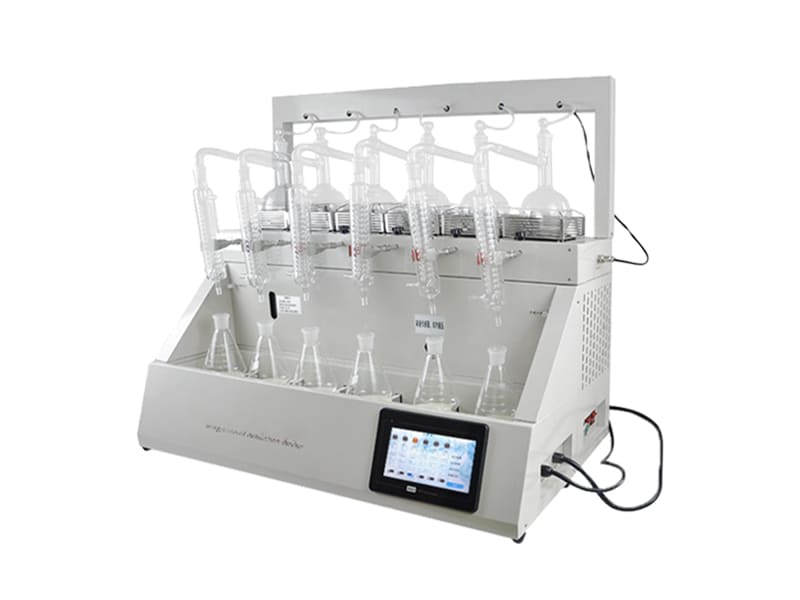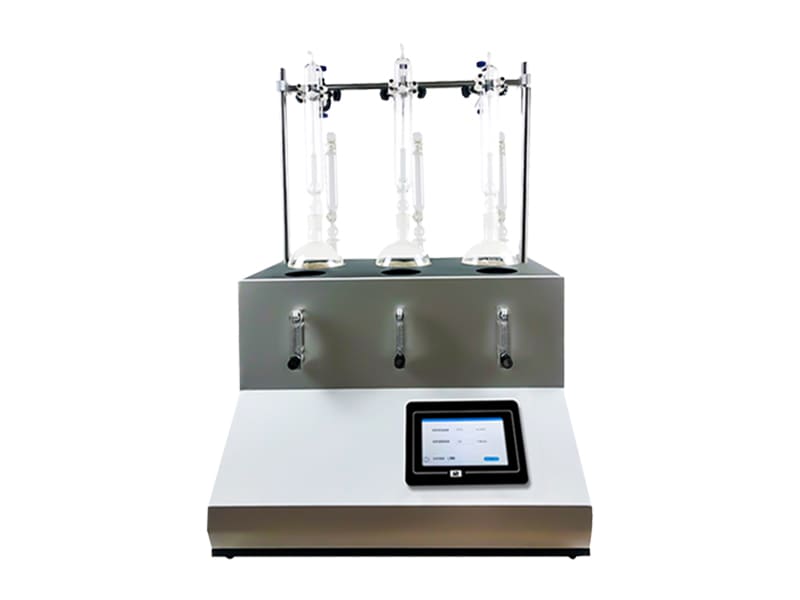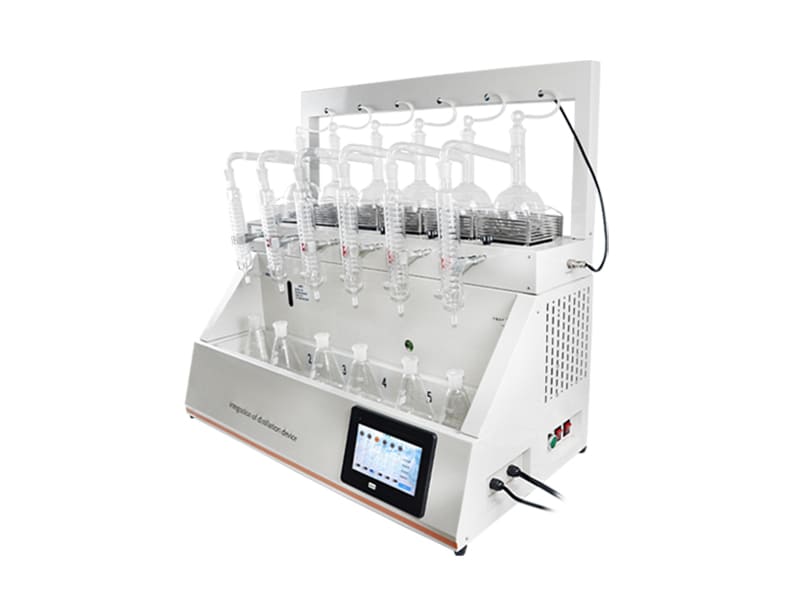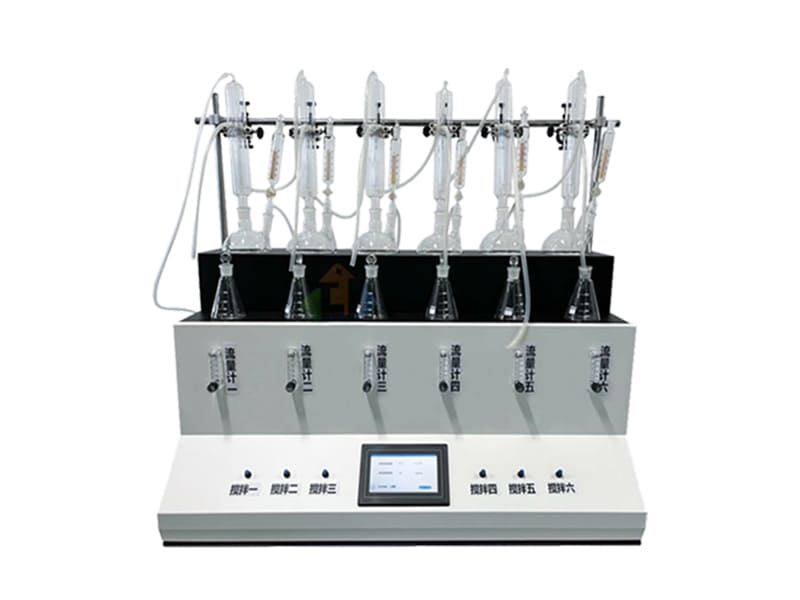Product Introduction
Distillation is a very common and important pre-treatment step in the water quality and instrument testing process at all levels of laboratories. However, traditional distillation devices, due to their independent heating, condensation, and reception parts, are cumbersome to operate and easily affected by cooling water sources, resulting in low efficiency, poor parallelism, low recovery rates, and other phenomena that directly affect experimental results.
This product adopts intelligent integrated equipment, using PTC (far-infrared ceramic heating) technology instead of high-power electric heaters, and adopts intelligent distillation endpoint control, built-in cooling water self cooling and plucking system, and specially customized patented condenser tubes. It achieves the goals of simple operation, automatic distillation, aesthetics and practicality, energy conservation and consumption reduction, and can be widely used in environmental monitoring, water supply and drainage, hydrological monitoring, product quality inspection, inspection and quarantine, scientific research institutes, universities, disease prevention and control centers, and other chemical laboratories that require distillation treatment. The field is suitable for the determination of volatile phenols, cyanide, water quality ammonia nitrogen, salicylic acid spectrophotometry, water in oil, etc. in project water samples.
Technological innovation points
This product is a new laboratory distillation device that integrates heating, distillation, cooling, and reception. It is one of the essential instruments for distillation projects at all levels of laboratories
Adopting far-infrared ceramic heating technology, infrared radiation heating (no open flame heating, waterproof). The power consumption is only a quarter of that of the original high-power electric heating, but the effect is equivalent to that of a ceramic heater, which is water-resistant and avoids circuit short circuits caused by water flooding
This instrument can produce 6 sets of samples at once, with 6 holes available for single hole single control. The heating temperature and heating time are automatically displayed on the large LCD screen. The distillate end is equipped with an anti backflow device and an anti vacuum solenoid valve to ensure one-way flow of the distillate and prevent backflow back into the flask
A snake shaped condenser tube designed with professional technical expertise, with fast distillation speed and good cooling effect
Technical parameter
1. Heating method: Using imported far-infrared ceramic heating furnace, infrared radiation heating (no open flame heating, waterproof);
2. Heating units: 6, single hole and single control;
3. Heating time: 5-8 minutes;
4. Distillation speed: 12ml/min;
5. Distillation endpoint control: Automatic detection of distillation endpoint function with high degree of automation;
6. Single furnace heating power: 0-450W (single hole adjustable);
7. High heating power: 0-2700W (adjustable);
8. Cooling method: external low-temperature circulating constant temperature bath)
9. Anti backsuction: equipped with an anti vacuum solenoid valve, with anti backsuction function; Each heating position is equipped with anti over protection and anti backflow protection to ensure safe and effective experimentation, as well as high sample recovery rate without loss. You can choose to use two cooling methods: external water source or external chiller, with automatic start and stop functions for external water source, saving energy and water.
10. Time control: adjustable from 0-200 minutes;
11. Distillation bottle specifications: 500mlX6250X6, more specifications available;
12. External dimensions: 890 * 440 * 800mm
13. Rated voltage/frequency: 220V/50Hz;
14. Composed of a 500ML Kai style flask, nitrogen ball, straight condensing tube, and guide tube, the end of the condensing tube can be connected to an appropriate length dropper, allowing the product tip to immerse below the absorption liquid level. Distillation flasks can also be used.
15. The operation interface can be set with no less than five national standard methods, and each national standard operation method can be customized with one click save/read, simplifying the experimental process (5 types of national standard glass can be optional). At the same time, the operation method can be customized with one click save/read, eliminating the need to set experimental parameters every time, improving work efficiency.
Experimental operation process
1. Add the distilled sample, required reagents, zeolite, water, etc. in sequence to the distillation flask and mix well.
Place the flasks into the heating holes one by one and seal them with the condenser tube.
Connect the distillate outlet of the condenser tube to the receiving bottle.
4. Place the receiving bottle tightly against the distillation endpoint probe, and if necessary, adjust the position of the distillation endpoint probe (the position of the distillation endpoint probe has been adjusted before leaving the factory. If adjustment is needed, please contact the manufacturer)
Turn on the power switch and design the required heating temperature and working time (the instrument factory has default settings)
6. Turn on the circulating cold water switch to allow the cooling water to circulate automatically
Press the switch for heating holes 1-6 as needed, and press the start button to start working.
When the distillate reaches the desired liquid level, the instrument will automatically stop heating and the distillation will be completed before shutting down.
matters needing attention
When the room temperature is above 25 degrees Celsius in summer, the cooling effect will decrease. It is recommended to use an external cooling water circulation device for cooling.
When the winter room temperature is below 0 degrees Celsius, it is necessary to do a good job in cold and warm protection of the instrument to prevent the condensation device from exploding and becoming unusable.
When using it for the first time, it is recommended to use pure water or distilled water when adding cooling water to prevent scale formation after long-term use. One full charge can circulate for more than six months
During the heating process, for instruments or sewage samples with severe boiling phenomena, the heating power knob can be adjusted to gradually increase the heating power, or several glass or silicone anti foaming agents can be added appropriately.
- Previous: Intelligent Distiller
- Next: Sulfur dioxide distiller



 Current
Location:
Current
Location:
 17853698681
17853698681 WhatsApp
WhatsApp Product Details
Product Details Related Products
Related Products









